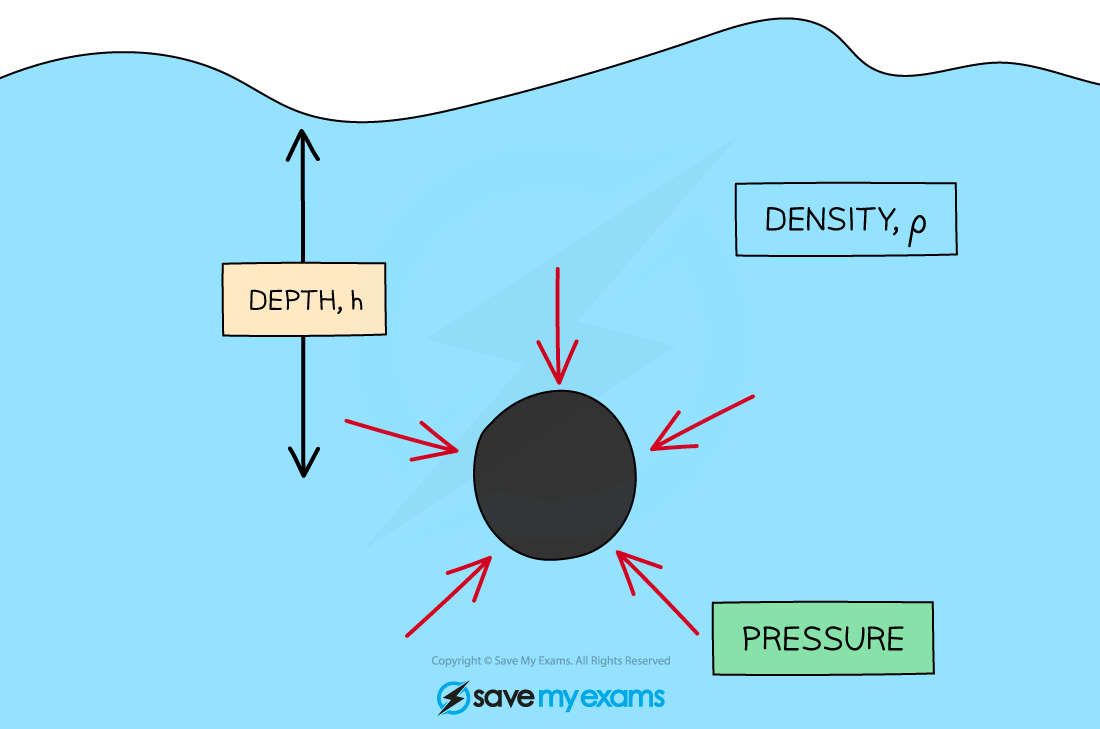Pressure in a Liquid (OCR GCSE Physics A (Gateway)) : Revision Note
Factors Affecting Pressure in a Liquid
Higher Tier Only
When an object is immersed in a liquid, the liquid will exert a pressure, squeezing the object
This pressure is exerted evenly across the whole surface of the liquid and in all directions
The greater the depth of the liquid, the greater the pressure
The greater the density of the liquid, the greater the pressure
In a liquid, the pressure at a point increases with the height of the column of liquid about that point
If there is more liquid above that point, then the pressure is more
This is because the pressure in a liquid is caused by the weight of the liquid pushing against objects immersed in the liquid
As the liquid becomes deeper, the amount of liquid (and hence the weight) increases which causes the pressure to increase
This is why, for example, the pressure increases with the depth of the ocean
The pressure on the seabed is far higher than that on the surface of the ocean
The weight of the liquid also depends on its density
A more dense liquid has a greater weight and therefore will exert a higher pressure

Pressure in a column of water increases with depth, shown by the strong and weak jet of water
In a column of water, the highest pressure would be at the bottom
If a hole is made at the bottom of the column, the water will pour out with a large force
If a hole was made at the top of the column, the water will pour out with a small force
This is because of the difference in pressure in the column caused by the weight of the water
Pressure Differences & Upthrust
Upthrust is due to the difference in pressure between the top and the bottom of the submerged object
A partially (or totally) submerged object experiences a greater pressure on the bottom surface than on the top surface
This is because the pressure p is proportional to the depth h of the object
The difference in pressure creates a resultant force upwards (upthrust)
Upthrust is why objects appear to weigh less when immersed in a liquid

Upthrust is due to the different pressure at the top and bottom of this cylinder
The amount of upthrust on an object depends on the weight of the fluid that the object displaces
Upthrust is equal to the weight of fluid displaced

Liquids exert an upwards force (upthrust) on objects immersed in them equal to the weight of the fluid displaced
Calculating Pressure in a Liquid
Higher Tier Only
The pressure due to a column of liquid can be calculated using the equation
p = h × ρ × g
Where:
p = pressure in pascals (Pa)
h = height of the column in metres (m)
ρ = density of the liquid in kilograms per metre cubed (kg/m3)
g = gravitational field strength on Earth in newtons per kilogram (N/kg)
The force from the pressure is exerted evenly across the whole surface of an object in a liquid, and in all directions

The force from the pressure of objects in a liquid is exerted evenly across its whole surface
The pressure is more accurately a difference in pressure at different depths h in a liquid, since the pressure changes with the depth
Worked Example
Calculate the depth of water in a swimming pool where a pressure of 20 kPa is exerted.
The density of water is 1000 kg/m3 and the gravitational field strength on Earth is 9.8 N/kg.
Answer:
Step 1: List the known quantities
Pressure, p = 20 kPa
Density of water,
= 1000 kg/m3
Gravitational field strength, g =9.8 N/kg
Step 2: List the relevant equation
Step 3: Rearrange for the height, h
Step 4: Convert any units
20kPa = 20 000 Pa
Step 5: Substitute in the values
Examiner Tips and Tricks
This pressure equation will be given on your formula sheet, however, make sure you are comfortable with rearranging it for the variable required in the question!

You've read 0 of your 5 free revision notes this week
Sign up now. It’s free!
Did this page help you?

